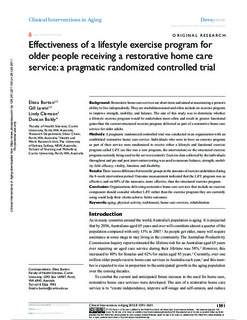| dc.contributor.author | Burton, E. | |
| dc.contributor.author | Lewin, G. | |
| dc.contributor.author | Clemson, Lindy M. | |
| dc.contributor.author | Boldy, D. | |
| dc.date.accessioned | 2017-06-07T12:37:53Z | |
| dc.date.available | 2017-06-07T12:37:53Z | |
| dc.date.issued | 2013 | |
| dc.identifier.citation | Burton, E., Lewin, G., Clemson, L. & Boldy, D. (2013) Effectiveness of a lifestyle exercise program for older people receiving a restorative home care service: a pragmatic randomized controlled trial. Clin Interv Aging, 8, s. 1591-1601. | |
| dc.identifier.uri | http://hdl.handle.net/11250/2444981 | |
| dc.description | Effekten av et livsstilprogram i hverdagsrehabilitering. | |
| dc.description.abstract | Background: restorative home care services are short-term and aimed at maximizing a person’s ability to live independently. They are multidimensional and often include an exercise program to improve strength, mobility, and balance. The aim of this study was to determine whether a lifestyle exercise program would be undertaken more often and result in greater functional gains than the current structured exercise program delivered as part of a restorative home care service for older adults. Methods: a pragmatic randomized controlled trial was conducted in an organization with an established restorative home care service. Individuals who were to have an exercise program as part of their service were randomized to receive either a lifestyle and functional exercise program called LiFE (as this was a new program, the intervention) or the structured exercise program currently being used in the service (control). Exercise data collected by the individuals throughout and pre and post intervention testing was used to measure balance, strength, mobility, falls efficacy, vitality, function, and disability. Results: there was no difference between the groups in the amounts of exercise undertaken during the 8-week intervention period. Outcome measurement indicated that the LiFE program was as effective, and on 40% of the measures, more effective, than the structured exercise program. Conclusion: organizations delivering restorative home care services that include an exercise component should consider whether LiFE rather than the exercise program they are currently using could help their clients achieve better outcomes. Keywords: aging, physical activity, reablement, home care services, rehabilitation. | |
| dc.language.iso | eng | |
| dc.rights | Navngivelse-Ikkekommersiell 4.0 Internasjonal | |
| dc.rights.uri | http://creativecommons.org/licenses/by-nc/4.0/deed.no | |
| dc.subject | hverdagsrehabilitering | |
| dc.subject | aging | |
| dc.subject | physical activity | |
| dc.subject | reablement | |
| dc.subject | home care services | |
| dc.subject | rehabilitation | |
| dc.title | Effectiveness of a lifestyle exercise program for older people receiving a restorative home care service: a pragmatic randomized controlled trial | |
| dc.type | Journal article | |
| dc.type | Peer reviewed | |
| dc.source.journal | Clinical Interventions in Aging | |
| dc.identifier.doi | doi:10.2147/cia.s44614 | |

